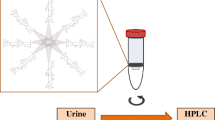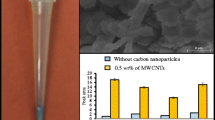Abstract
Bisphosphonates are poorly sorbed from the gastrointestinal tract, therefore, the urinary recovery ratio after oral administration is an important parameter to control. Analysis of bisphosphonates in biological samples causes challenges due to their chemical properties. Their high solubility in water and extensive ionization cause that reported tedious sample extraction methods generally involved a combination of multiple extraction steps. Therefore, competitive solution to the conventional sample preparation techniques was proposed in this work. Aminated poly(styrene–divinylbenzene–vinylbenzyl chloride) monoliths and aminated poly(divinylbenzene–vinylbenzyl chloride) were prepared by in situ polymerization in stainless steel needles. Amination of polymerized monolith was carried out by trimethylamine or pyridine. Several research methods were applied to assess the modification of monolithic materials: Energy dispersive X-ray Spectrometry, scanning electron microscope images and Fourier Transform Infrared Spectroscopy. Artificial urine used as simulated body fluid containing sodium risedronate as standard compound was passed through monolithic in-needle extraction (MINE) device. The amount of analyte in eluate solutions was measured using HPLC system. The effectiveness of complete desorption process was over 95% with using potassium phosphate solution (pH 7.8) as eluent.







Similar content being viewed by others
References
R. Graham, G. Russell, Bisphosphonates: the first 40 years. Bone 49, 2–19 (2011)
E.L. George, Y.-L. Lin, M.M. Saunders, Bisphosphonate-related osteonecrosis of the jaw: a mechanobiology perspective. Bone Reports 8, 104–109 (2018)
J.H. Lin, Bisphosphonates: a review of their pharmacokinetic properties. Bone 18, 75–85 (1996)
S. Ghassabian, L.A. Wright, A.D. deJager, M.T. Smith, Development and validation of a sensitive solid-phase-extraction (SPE) method using high-performance liquid chromatography/tandem mass spectrometry (LC–MS/MS) for determination of risedronate concentrations in human plasma. J. Chromatogr. B 881, 34–41 (2012)
W.F. Kline, B.K. Matuszewski, Improved determination of the bisphosphonate alendronate in human plasma and urine by automated precolumn derivatization and high-performance liquid chromatography with fluorescence and electrochemical detection. J. Chromatogr. Biomed. Appl. 583, 183–193 (1992)
C.K. Zacharis, P.D. Tzanavaras, Determination of bisphosphonate active pharmaceutical ingredients in pharmaceuticals and biological material: a review of analytical methods. J. Pharm. Biomed. Anal. 48, 483–496 (2008)
R.W. Sparidans, J. Den Hartigh, S. Cremers, J.H. Beijnen, P. Vermeij, Semi-automatic liquid chromatographic analysis of olpadronate in urine and serum using derivatization with (9-fluorenylmethyl) chloroformate. J. Chromatogr. B Biomed. Sci. Appl. 738, 331–341 (2000)
H.J. Leis, G. Fauler, W. Windischhofer, Use of 18O3-clodronate as an internal standard for the quantitative analysis of clodronate in human plasma by gas chromatography/electron ionisation mass spectrometry. Rapid Commun. Mass Spectrom. 18, 2781–2784 (2004)
M.J. Lovdah, D.J. Pietrzyk, Anion-exchange separation and determination of bisphosphonates and related analytes by post-column indirect fluorescence detection. J. Chromatogr. A 850, 143–152 (1999)
M. Pietrzyńska, A. Voelkel, K. Bielicka-Daszkiewicz, Preparation and examination of monolithic in-needle extraction (MINE) device for the direct analysis of liquid samples. Anal. Chim. Acta 776, 50–56 (2013)
M. Pietrzyńska, K. Adamska, M. Szubert, A. Voelkel, Solubility parameter used to predict the effectiveness of monolithic in-needle extraction (MINE) device for the direct analysis of liquid samples. Anal. Chim. Acta 805, 54–59 (2013)
M. Pietrzyńska, A. Voelkel, Optimization of the in-needle extraction device for the direct flow of the liquid sample through the sorbent layer. Talanta 129, 392–397 (2014)
K. Kędziora, W. Wasiak, Extraction media used in needle trap devices—progress in development and application. J. Chromatogr. A 1505, 1–17 (2017)
M. Pietrzyńska, R. Brożek, A. Voelkel, R. Koczorowski, In-needle extraction technique in determination of organic compounds released from dental tissue conditioners incubated in artificial saliva. Talanta 129, 203–208 (2014)
Tong s., Liu S., H. Wang, Q. Jia, Recent advances of polymer monolithic columns functionalized with micro/nanomaterials: synthesis and application. Chromatographia 77, 5–14 (2014). https://doi.org/10.1007/s10337-013-2564-x
N. Barlık, B. Keskinler, M.M. Kocakerim, G. Akay, Surface modification of monolithic PolyHIPE polymers for anionic functionality and their ion exchange behavior. J. Appl. Polym. Sci 132, 42286–42293 (2015)
H.A. Ezzeldin, A. Apblett, G.L. Foutch, Synthesis and properties of anion exchangers derived from chloromethyl styrene codivinylbenzene and their use in water treatment. Int. J. Polym. Sci. (2010). https://doi.org/10.1155/2010/684051. https://www.hindawi.com/journals/ijps/2010/684051/
M. Pietrzyńska, R. Tomczak, K. Jezierska, A. Voelkel, J. Jampílek, Polymer-ceramic monolithic in-needle extraction (MINE) device: preparation and examination of drug affinity. Mater. Sci. Eng. C 68, 70–77 (2016)
L. Liu, L. Shou, H. Yu, J. Yao, Mechanical Properties and corrosion resistance of vulcanized silicone rubber after exposure to artificial urine. J. Macromol. Sci. Part B 54, 962–974 (2015)
M. Pietrzyńska, A. Voelkel, Stability of simulated body fluids such as blood plasma, artificial urine and artificial saliva. Microchem. J. 134, 197–201 (2017)
D.B. Rorabacher, Statistical treatment for rejection of deviant values: critical values of Dixon’s “Q” parameter and related subrange ratios at the 95% confidence level. Anal. Chem. 63, 139–146 (1991)
Acknowledgements
This study was funded by the Polish National Science Centre, Grant No. 2013/11/D/ST4/02829.
Author information
Authors and Affiliations
Corresponding author
Ethics declarations
Conflict of interest
The authors declare no conflicts of interest.
Rights and permissions
About this article
Cite this article
Zielińska, M., Voelkel, A. Risedronate extraction from artificial urine with using monolithic polymer-based anion exchangers. J IRAN CHEM SOC 16, 93–100 (2019). https://doi.org/10.1007/s13738-018-1484-y
Received:
Accepted:
Published:
Issue Date:
DOI: https://doi.org/10.1007/s13738-018-1484-y




